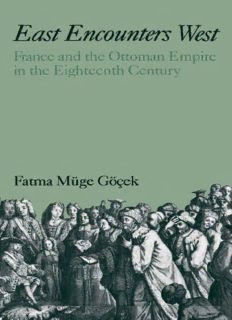
East Encounters West: France and the Ottoman Empire in the Eighteenth Century (Studies in Middle Eastern History) PDF
Preview East Encounters West: France and the Ottoman Empire in the Eighteenth Century (Studies in Middle Eastern History)
East Encounters West STUDIES IN MIDDLE EASTERN HISTORY Bernard Lewis, Itamar Rabinovich, and Roger Savory, General Editors Israel Gershoni and James P. Jankowski EGYPT, ISLAM, AND THE ARABS The Search for Egyptian Nationhood, 1900–1930 Ami Ayalon LANGUAGE AND CHANGE IN THE ARAB MIDDLE EAST Fatma Miige Gogek EAST ENCOUNTERS WEST France and the Ottoman Empire in the Eighteenth Century Other Volumes Are in Preparation EAST ENCOUNTERS WEST France and the Ottoman Empire in the Eighteenth Century FATMA MÜGE GÖEK New York Oxford OXFORD UNIVERSITY PRESS In cooperation with The Institute of Turkish Studies, Inc., Washington, D.C. 1987 Oxford University Press Oxford New York Toronto Delhi Bombay Calcutta Madras Karachi Petaling Jaya Singapore Hong Kong Tokyo Nairobi Dar es Salaam Cape Town Melbourne Auckland and associated companies in Beirut Berlin Ibadan Nicosia Copyright © 1987 by Oxford University Press, Inc. Published by Oxford University Press, Inc., 200 Madison Avenue, New York, New York 10016 Oxford is a registered trademark of Oxford University Press All rights reserved. No part of this publication may be reproduced, stored in a retrieval system, or transmitted, in any form or by any means, electronic, mechanical, photocopying, recording, or otherwise, without the prior permission of Oxford University Press. Library of Congress Cataloging-in-Publication Data Göçek, Fatma Mϋge. East encounters West. (Studies in Middle Eastern history) Bibliography: p. Includes index. 1. Turkey—Civilization—French influences. 2. Turkey—Civilization— Occidental influences. 3. Turkey—Diplomatic and consular service— France—History—18th century. I. Title. II. Series: Studies in Middle Eastern history (New York, N.Y.) DR432.G57 1987 956.1'01 86-23727 ISBN 0-19-504826-1 135798642 Printed in the United States of America To my parents Gϋlsen and Muzaffer Göçek, with gratitude This page intentionally left blank PREFACE Books evolve from the experiences of their authors. I can trace the idea for this book to my undergraduate years in Turkey during the 1970s when that country was trying to come to terms with social unrest. This unrest alerted me to the tension between the Eastern and Western civilizations in Turkey and as I explored this tension and tried to get to its roots, I found myself absorbed more and more in Ottoman history. Using an Ottoman embassy account to Paris in 1720–1721 as my starting point, I tried to understand the process by which the West influenced the Ottoman Empire throughout the eighteenth century. My primary scholarly debt is to Bernard Lewis. Had it not been for his constant attentiveness to my work, his thorough critique, and his continuous support and encouragement, I would not have been able to develop this work into a book. I am also indebted, for their invaluable comments on earlier versions of this book, to Halil Inalcik, Heath Lowry, Gilles Veinstein on Ottoman history, Said Arjomand, Judith Herrin, Charles Issawi on historical analysis, Suzanne Keller, Robert Leibman, and Gilbert Rozman on social analysis, and Robert Palmer on French history. I would also like to thank Amy Singer who gave the manuscript a thorough reading. I must express my appreciation to the students and teachers of the Near Eastern Studies and Sociology Departments of Princeton University from whose questions and comments I derived much benefit. I also learned from the comments I received during the two talks I gave on the Ottoman embassy account, one at the Third International Congress of the Social and Economic History of Turkey at Princeton in 1983, and the other at the Sadberk Hanim Mϋzesi in Istanbul in 1985. Needless to say, although all those from whom I have benefited account for much that is valuable in this book, I alone am responsible for any of its shortcomings. VIII PREFACE Most of the illustrations in the book are from the Topkapi Museum Library; I would like to thank the Library director Filiz Çağman who was most suppor- tive during my research in Istanbul. The Bibliothèque Nationale, especially Mileva Bozič, and the French museums were most cooperative in providing the French illustrations. Finally, I owe an immeasurable debt of thanks to my husband Charles Hammerslough who helped me type, read my chapters, and was there when I needed him. Princeton F.M.G. October 1986 CONTENTS Illustrations, xi Note on Transcription and Pronunciation, xiii PART I Interaction Between Two Societies Through an Embassy Introduction, 3 1. Initiation of the Embassy and the Voyage, 7 2. The Cultural Interaction, 24 3. The Return, 62 4. The Impact of the Embassy, 72 PART II Factors Affecting the Interaction and the Western Impact 5. Comparison of Three Ottoman Embassies, 85 PART III Factors Affecting the Spread of Western Impact in Ottoman Society 6. Commerce, 97 7. Technology, 103 8. Social Groups in Ottoman Society, 116 9. Conclusion, 136
Description: